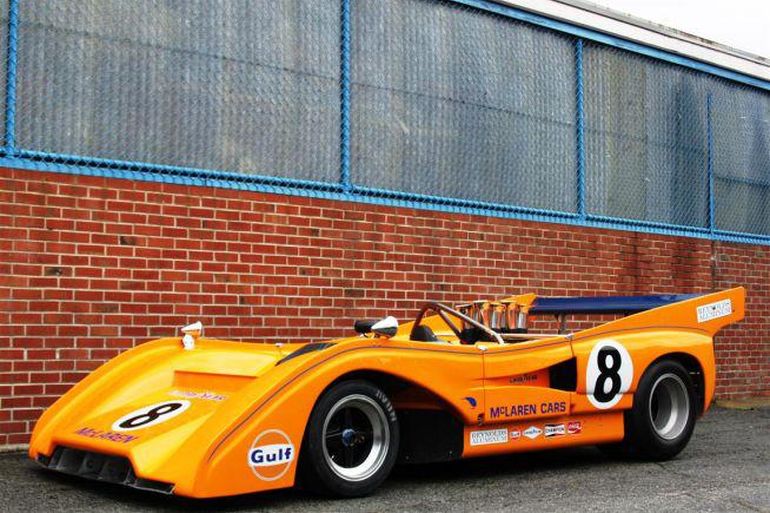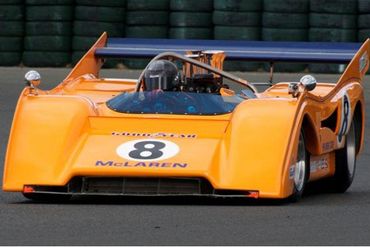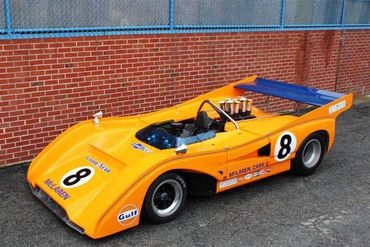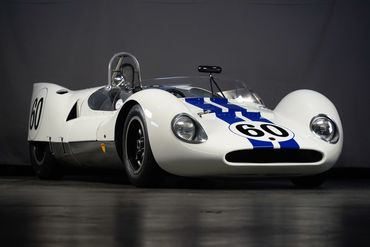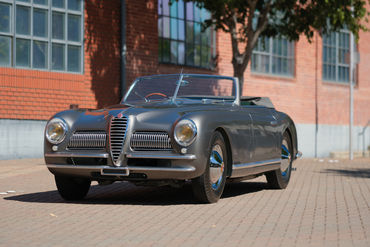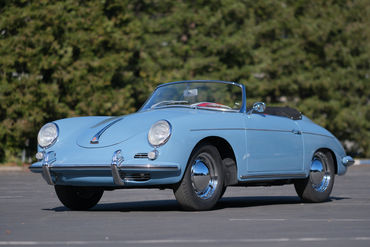Sold
SOLD 05/13
1973 McLaren
M8FP
See New Pricing! Outstanding Example of the Legendary M8F with Period Can-Am History. Excellent Mechanical and Cosmetic Condition.
- VINEx-Commander Motor Homes Team Car
- Exterior ColorMcLaren Factory Livery Orange
- Interior ColorBlack
- MileageTMU
- EngineDart 510 c.i. Alloy Block
- Transmission4-Speed
- StatusSold
- StockFJ1100
Description
1973 McLaren M8FP
Ex-Commander Motor Homes Team Car
McLaren Factory Livery Orange
The Canadian American Challenge Cup series was a unique experiment in almost complete freedom of design. So often in motorsports strict limitations imposed, but in the case of Can Am, just about anything went. Engines could be any displacement or design, with forced induction, outlandish aerodynamic aids, and even four wheel drive permitted. The resulting cars were very wild, and very fast, faster than even the contemporary Formula One cars, in fact.
McLaren`s own efforts were very successful in the series, amassing more victories than any other manufacturer (43) by the time the series ended in 1974. Their tremendous success began with their first monocoque car, the M6A of 1967. This car evolved into the M8A with the addition of a big block motor for 1968, and the M8B and M8D with further refinements for 1969 and 1970 respectively. The M8F was the ultimate development (aside from a pair of M20`s which were factory cars only and not available to the public) of McLaren`s successful Can Am cars, and featured a lengthened and strengthened chassis, 17-inch wide rear wheels, and revised aerodynamics. The intake stacks were staggered to smooth out the power delivery, and the combined effect of the 1520 pound curb weight and 8.3 liter engine were nothing short of spectacular, earning the moniker of `the ultimate laxative` as coined by the folks at Trojan Cars. Despite the massive displacement, the engine redlined at 7000 rpm, a remarkable feat for an engine with `pistons like flower pots` and `valves like umbrellas`, as characterized by Autosport Magazine.
This particular chassis is one of five McLaren Can-Am cars owned and raced in period by the Commander Motor Homes Racing team. Two of the five cars were factory M8Fs which Peter Revson and Denny Hulme had driven to an easy one-two finish in the 1971 Can-Am championship before selling both onward to Gregg Young of the Young American Racing Team. Greg drove the Hulme car himself until damaging it at Mid Ohio and again at Edmonton, while Francois Cevert drove the Revson car through a successful season and placed fifth in championship points. The Young American Racing Team sold both the chassis they had bought from McLaren directly to the Commander Motor Homes Racing Team for competition during the 1973 seasons.
Commander Motorhome’s third car was a Trojan (licensed supplier for all customer McLaren M8Fs tubs) built chassis, which has very slight technical differences to the factory M8Fs. The Commander team paid dearly for the 9th and final complete Trojan M8FP, s/n 72-09, was purchased slightly used from a fellow Can-Am racer named Bill Cuddy. By all accounts it was in almost new condition. Originally delivered in baby blue gel coat, Commander Motor Homes painted 72-09 white and assigned it number 98. Chassis number 72-09 was damaged badly at Edmonton while being driven by Danny Hopkins.
The fourth car campaigned by the Commander Motor Homes team was built from a spare M8FP tub (chassis number unassigned) provided by Trojan cars and was utilized for the final remaining rounds of the 1973 season, assuming their race number 98, and showing Danny Hopkins as the driver. Parts retained by the Commander Motor Homes team were used in the mid-year 1973 construction of this car including front uprights from an M20.
The fifth and final McLaren run by the Commander Motor Homes team was an entirely different chassis; an M20, which was purchased by the team in the hopes that Mario Andretti would join on as a driver.
In summary, the chassis offered here replaced chassis no. 9-72, which was driven by Danny Hopkins during the 1973 Can-Am season, and was heavily damaged at Edmonton Raceway during the same year. As the team wanted to make the following race meeting at Laguna Seca, a replacement chassis supplied from Trojan was built up and fitted with spare M20 front uprights, and a Porsche 917 style front body section, among other unique improvements. This chassis was the Commander Motor Homes #98 entry at Langua Seca and Riverside in 1973, with Hopkins at the wheel. The actual monocoque which is presented here is that which participated in the 1973 Can-Am race meetings during the latter part of the season, although in the rush to prepare new car for the upcoming round at Laguna Seca, the chassis number plate which may have existed on the no. 9-72 monocoque was never physically transferred over to this car, and accordingly, we refer to the car as the “#98 Commander Motor Homes team car.”
We are aware that at some point in the car’s history the concept that Peter Revson drove this particular chassis during the 1971 season was introduced, and considerable confusion exists about the relationship of this chassis to that which Peter Revson drove, which is actually s/n 1. In short, we do not believe there is any direct relation beyond the concurrent ownership of the two chassis by the Commander Motor Homes Racing Team, and that the appropriate period livery for this car would have been white, as seen in many period photos.
This car was purchased by the Nearburg Family, now well known in the historic racing community, for selected races during the 1975-1977 Can-Am seasons where it was entered at Road Atlanta, Mosport, and Road America, with a best finish of 9th at Mosport in 1976.
The full ownership sequence for this chassis is as follows: Commander Motor Homes Racing Team, Nearburg, Crompton, Joel Finn, Bill Wonder, Scott Hughes.
The car has been the subject of a comprehensive restoration and is currently in excellent mechanical condition. It is also in excellent cosmetic condition, with virtually no wear to the paint since being repainted. Period McLaren team graphics have been faithfully replicated and the aluminum monocoque is excellent, having been recently polished so that it shines. The remainder of the chassis and mechanical components are in excellent order as well, displaying very fine historic race car cosmetics, as well as some very remarkable engineering.
With the car comes select documentation from the current and previous ownership period, period photos in digital format, magazines featuring several articles on the car, two extra wheels, several gear sets, and a helpful box of track support items to assist the new owner in running this remarkable racing machine.
The car was a successful participant at the Wine Country Historic Races in May of 2011, and remains an outstanding example of the legendary M8F with important period racing history. The Can-Am series represented a genuinely historic time. Never before or since have drivers, designers, or enthusiasts had such a free hand to really explore the potential of the automobile, and these cars truly do represent a heroic and unrepeatable era. This particular car, with its recent and thorough preparation, excellent cosmetic condition, and historical importance, is an extremely attractive way to pay homage to and recapture this important and exciting period.
The above vehicle information is complete and accurate to the best of our knowledge at the time it is posted to this website. Corrections or additional information is always appreciated. All advertised prices exclude government fees and taxes, any finance charges, any dealer document preparation charge, and any emission testing charge. Vehicles are subject to prior sale. All advertised to be true but not guaranteed. We assume no liability for errors or omissions.
Inquire About This Car
Fantasy Junction • 510-653-7555 • 1145 Park Ave, Emeryville, CA 94608
